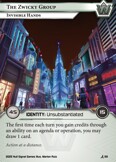Maintenance Access (🥷) is an “Event-ified Sneakdoor Beta”! It:
gives you an HQ-Success, not just HQ-Breach (unlike Virtuoso, Eru Ayase-Pessoa, or Beatriz Friere Gonzalez). You will trigger a Maglectric Rapid or PAN-Weave, help enable Jeitinho, and so on.
replaces with a “Re-Approach” (
would approach Archives … change the attacked server to HQ and approach HQ), like Sneakdoor’s “Re-Declare” (would be declared successful … change the attacked server to HQ). The run will still getdeclared successfulon HQ, not Archives (and will also triggers any defensive upgrades, FWIW).is a
Double. To Deep Dive by running Archives twice (and R&D once), you'll need an extra click (from Sable and/or Swift). BTW, if you installed a Sneakdoor or Slipstream on the turn you use it, then it became a “pseudo–Event: Run - Double” anyways.is an Event (not a Program), which taxes “−1 Hand-Size, −0 Memory-Limit”. Unlike SB’s
−2[mu](which taxed both).
Design
Pinhole Threading is the “horizontal” complement to “vertical” bypass/derez/rez-tax effects (like Inside Jobs, Windows of Opportunity, or Tread Lightly’s).
“Passing-Horizontally” cards can:
- “distort” (non-derogatory) ice-placement differently, such as: the Corp icing Archives to protect HQ against MA (and not just double-/triple-icing HQ to protect against Inside Job, Bankhar, etc).
“reify” dynamic play-patterns, such as: run HQ (force ice rez there, maybe even jacking out afterwards), then run remote (if ice here would be unrezzible). That is, if NSG printed a “Central→Remote Redirect”, like:
Run a central server. When you would approach that server, instead change the attacked server to a remote server (if able) and approach it.(passes ice)Run a central server. If that run would be declared successful, change the attacked server to a remote server for the remainder of that run.(passes upgrades too)
However, Runner-side server-redirection rarely gets printed, so I've been wanting more for years (especially as Criminal events). Below was my custom card (designed once I realized Sneakdoor was rotating). It was also a Double, but because of the extra value (multiaccess, draw), not to avoid Deep Dive (since mine wasn't play tested, theirs was LOL). And it let you hit R&D as well as HQ, so that Criminals could attack R&D (like for Zahya and WAKE Implant), the way Shapers can pressure HQ (like with Burner).
Sneakdoor Heist
[$1] Event: Run - Double
[criminal 3/5]
As an additional cost to play this event, spend [click].
Run Archives.
If that run would be declared successful, change the attacked server to HQ or R&D for the remainder of that run.
When you breach the attacked server, access 1 additional card.
Synergies
HQ-Succeeding/Breaching triggers/checks (non-Event):
- Maglectric Rapid (
derezanything anywhere) - Lucky Charm?
- WAKE Implant (to charge for R&D)
- Detente?
- Jeitinho (or Deep Dive, with extra clicks)
- PAN-Weave (drain a credit) + Info Bounty (if HQ is
marked) + Zahya
HQ-Multiaccess:
- Docklands Pass
- Cupellation
- The Twinning, Manuel Lattes de Moura?, etc
- Mercury (especially with uniced Archives)
- Virtuoso?
See x:hq t!event d:r
“Run-Events-matter”:
- MuslihaT (draws it).
- Swift (reimburses the Double 's click-loss).
- Sang Kancil? (irrelevant, unless Archives is Code-Gate’d)





Can the Click ability be used even if Petty Cash is facedown in archives?
— scantrell24